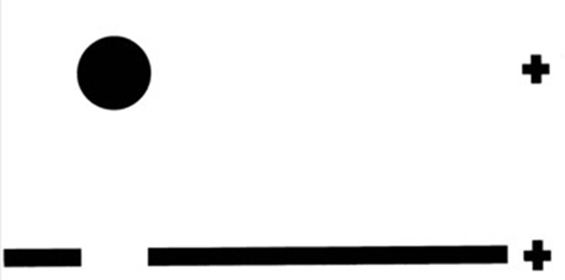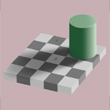Thursday, 11 February 2021
Revisiting an optical illusion in terms of predictive processing
 I recently came across a little experiment that I posted years ago on this website to show how the blind spot in each of your eyes works. The blind spot is a part of the retina where there are no photoreceptors, because it is where the axons of the retina’s ganglion cells converge and exit the eye, forming the optical nerve. As a result, there’s a corresponding area in your field of vision that doesn’t register on the retina. Hence, in theory, you shouldn’t see anything there. But in reality, you don’t see any such blank spot in your field of vision.
I recently came across a little experiment that I posted years ago on this website to show how the blind spot in each of your eyes works. The blind spot is a part of the retina where there are no photoreceptors, because it is where the axons of the retina’s ganglion cells converge and exit the eye, forming the optical nerve. As a result, there’s a corresponding area in your field of vision that doesn’t register on the retina. Hence, in theory, you shouldn’t see anything there. But in reality, you don’t see any such blank spot in your field of vision.
To find out why not, let’s revisit this optical illusion from the standpoint of predictive-processing theory, which has become more and more accepted in cognitive science over the past 10 years or so. (more…)
The Senses | Comments Closed
Monday, 4 February 2013
Adelson’s Checkerboard
 Optical illusions are always a humbling experience for people who think that they see the world “the way it really is”. Often, when such people are confronted with optical illusions induced by context, the context has to be removed and then restored several times before these people can be convinced that, for example, two lines that appear to be different lengths are actually the same.
Optical illusions are always a humbling experience for people who think that they see the world “the way it really is”. Often, when such people are confronted with optical illusions induced by context, the context has to be removed and then restored several times before these people can be convinced that, for example, two lines that appear to be different lengths are actually the same.
The world that we see is often ambiguous, and our visual system tries to give it a meaning on the basis of certain recurrent clues. Scientists today are familiar with some of these clues and can combine them to produce some truly astounding optical illusions. One famous example is Adelson’s checkerboard, in which one square is perceived as black and another as white, even though both are actually the same shade of grey! (more…)
The Senses | Comments Closed
Monday, 11 June 2012
The Phi Effect Is Not the Beta Effect!
 Science is not immune to historic errors that can be passed along for decades. One such error was the confusion of the phi effect with the beta effect, which persisted until Robert M. Steinman and his colleagues published their clarification in 2000.
Science is not immune to historic errors that can be passed along for decades. One such error was the confusion of the phi effect with the beta effect, which persisted until Robert M. Steinman and his colleagues published their clarification in 2000.
The phi effect was first described in Experimental Studies on the Seeing of Motion, a book published in 1912 by Max Wertheimer, one of the fathers of Gestalt psychology. The problem was that in his book, Wertheimer did not describe the conditions for the appearance of the phi effect precisely. He said that this phenomenon occurs when two lines are projected on a screen in very close chronological succession, thus creating the impression (under certain observation conditions that he left undefined) that a fuzzily defined area the same colour as the background is moving between these two lines. (more…)







